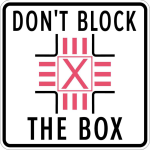Automobiles Laws and policies Safety: Driving tips
by Brian
Comments Off on DRIVING TIP #2: Don’t block the box!
DRIVING TIP #2: Don’t block the box!
 This week, San Antonio police began targeted enforcement of the state’s law against stopping in an intersection. The stepped-up enforcement is part of a pilot project called “don’t block the box”, where the “box” is the intersection and adjacent crosswalks. The program is modeled on similar programs in other cities. Ten problematic intersections all over San Antonio are part of this pilot project and have had signs like the one shown here installed. (Understand, though, that the law applies to all intersections, not just those marked with signs.) This is a statewide problem, so keep reading even if you’re not in San Antonio.
This week, San Antonio police began targeted enforcement of the state’s law against stopping in an intersection. The stepped-up enforcement is part of a pilot project called “don’t block the box”, where the “box” is the intersection and adjacent crosswalks. The program is modeled on similar programs in other cities. Ten problematic intersections all over San Antonio are part of this pilot project and have had signs like the one shown here installed. (Understand, though, that the law applies to all intersections, not just those marked with signs.) This is a statewide problem, so keep reading even if you’re not in San Antonio.
The law behind the program is §545.302(a) of the Texas Transportation Code and has been on the books pretty much forever but is often not known by drivers (or known but flagrantly violated.) It reads as follows:
Sec. 545.302. STOPPING, STANDING, OR PARKING PROHIBITED IN CERTAIN PLACES.
(a) An operator may not stop, stand, or park a vehicle:
(1) on the roadway side of a vehicle stopped or parked at the edge or curb of a street;
(2) on a sidewalk;
(3) in an intersection;
(4) on a crosswalk;
(5) between a safety zone and the adjacent curb or within 30 feet of a place on the curb immediately opposite the ends of a safety zone, unless the governing body of a municipality designates a different length by signs or markings;
(6) alongside or opposite a street excavation or obstruction if stopping, standing, or parking the vehicle would obstruct traffic;
(7) on a bridge or other elevated structure on a highway or in a highway tunnel;
(8) on a railroad track; or
(9) where an official sign prohibits stopping.
As you can see, the law is pretty straightforward.
The most common things that drivers do that violate the law are:
- Enter the intersection on a green when there’s traffic across the intersection that blocks the way out. Just because you have a green light does not give you carte blanche to enter the intersection; there are several circumstances where you are prohibited from entering on a green, and the presence of congestion that blocks your way out of the intersection is one of them. If that means you have to wait through an extra cycle, so be it. Blocking the intersection is a “d–k move” at best and can be outright hazardous at worse.
- Stop in the crosswalk when the light is red instead of stopping before the crosswalk (or stop bar if there is one.) This blocks the crosswalk and forces pedestrians who are crossing to have to go around the stopped vehicle, oftentimes into the intersection where traffic is also passing by, thereby endangering the pedestrians. For people in wheelchairs or with strollers, this can be especially problematic as they need more room.
- Stop in the correct position but then move forward into the crosswalk and stop again either out of impatience or to look and see if the way is clear to make a right on red. Getting cited for the latter movement is rather nit-picky I’ll admit, but it is still technically a violation. (If you’re a police officer reading this, I would encourage you to give folks a break on that one if they stopped in the proper location first before they moved up to check traffic.) Some people think that inching forward will somehow magically trigger the light to turn green; it doesn’t. Traffic sensors are installed to detect vehicles waiting in the proper spot and they recognize vehicles standing still just fine.
If you realize you habitually do any of the above, get out of the habit. Even if you’re not a habitual offender (or don’t know that you are), pay extra attention at intersections so that you get into the habit of stopping correctly.
A ticket for violating this law comes with a $200 fine.
That said, there is a time when stopping in the intersection is legal and should be done. I’ll discuss that next time.
The fine print
As always, the tip above is my own layman’s opinion and is intended as general information that can’t cover every possible scenario, so always use your own best judgement. If you need legal advice, consult a lawyer as I am not a lawyer nor do I play one on TV.